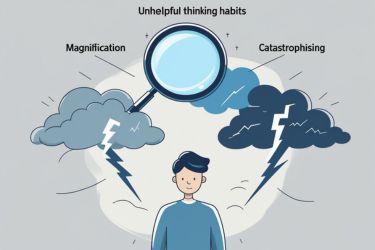Unhelpful thinking habits can cloud our judgement and affect our mental health. All-or-nothing thinking is one of the most common patterns, leading us to see situations in extreme terms without recognising the grey areas. This type of thinking can set us up for disappointment, as we often find ourselves feeling not good enough or overwhelmed by impossible expectations.

By identifying and addressing all-or-nothing thinking, we can shift our perspective and improve our emotional well-being. This article will explore how this mental trap affects us, the triggers that often lead to these thoughts, and strategies we can use to overcome them. Learning to recognise and challenge these patterns can lead to a healthier, more balanced mindset.
Key Takeaways
- All-or-nothing thinking creates unrealistic expectations that can harm our self-image.
- Recognising triggers can help us manage our thoughts more effectively.
- Implementing strategies to counteract this thinking can improve our overall mental health.
Understanding All-Or-Nothing Thinking

All-or-nothing thinking is a common unhelpful thinking style. It often leads to negative thoughts and cognitive distortions that can affect our mental health. This section will define this thinking pattern, help us recognise negative automatic thoughts, and explore its connection to cognitive distortions.
Defining All-Or-Nothing Thinking
All-or-nothing thinking involves viewing situations in black-and-white terms. We might think something is either perfect or a complete failure, with no middle ground. For example, if we miss a small target, we may feel like we have failed entirely.
This thinking style does not reflect reality accurately. Life is often not so clear-cut. Many situations and experiences fall somewhere in between. Understanding this helps us see the complexity of our thoughts and reactions.
Recognising Negative Automatic Thoughts
Negative automatic thoughts are quick, often untrue thoughts that pop into our minds without us realising. They can come from all-or-nothing thinking, leading us to feel insecure or defeated.
To identify these thoughts, we should pay attention to our feelings and self-talk. We might notice phrases like “I always mess up” or “I can never do anything right.” Recognising these patterns is the first step in challenging and changing them.
All-Or-Nothing Thinking and Cognitive Distortions
All-or-nothing thinking is a type of cognitive distortion. Cognitive distortions are unhelpful thought patterns that lead to negative feelings. By seeing things in extremes, we often overlook important details that could offer a more balanced perspective.
This type of thinking can harm our self-esteem and overall well-being. We might often feel anxious or depressed because of these distorted views. It's essential to challenge this thinking style and replace it with a more flexible approach. For example, instead of saying, “I failed this test,” we might say, “I can learn from this experience.”
By understanding and addressing all-or-nothing thinking, we can improve our mental health and develop a more realistic outlook on life.
The Impact of All-Or-Nothing Thinking

All-or-nothing thinking can greatly affect our lives. It shapes how we view ourselves, influences our mental health, and is often linked to feelings of anxiety and depression. Let’s explore these impacts in detail.
Effects on Self-Esteem and Confidence
All-or-nothing thinking can lead to low self-esteem. When we expect perfection from ourselves, we often feel like failures when we don’t reach those high standards. This pattern can create a negative cycle. For example, if we only see success as an "A" or complete failure, any grade lower can hurt our confidence.
Our self-worth may become tied to our achievements. If we perceive ourselves as failing, our confidence takes a significant hit. Over time, we may start to avoid challenges altogether. This avoidance can prevent us from recognising our true potential and exploring new opportunities.
Consequences for Mental Health
This type of thinking is linked to various mental health issues. It can contribute to heightened levels of stress and anxiety. When we constantly view situations in black-and-white terms, we may become overwhelmed. For instance, we might think, "If I don’t get this job, I’ll never succeed." Such thoughts can spiral into deeper feelings of hopelessness.
We should be mindful that all-or-nothing thinking can also lead to depression. When we view ourselves as failures, we may struggle to see our strengths. This distorted thinking can cloud our perception of reality. We might miss out on positive experiences that could enhance our mental well-being.
Relationship to Anxiety and Depression
There is a clear link between all-or-nothing thinking and increased anxiety and depression. For many of us, this type of thinking can manifest during periods of stress. We might feel anxious about meeting certain expectations, fearing that failure is inevitable.
People who experience anxiety often engage in this thinking pattern. They might find themselves thinking, "If I don’t excel, I will disappoint everyone." Such beliefs can exacerbate anxiety, making it difficult to cope with everyday situations.
Moreover, this way of thinking can trap us in a cycle of negativity. If we continuously focus on extremes, it becomes challenging to appreciate the nuances in life. We might miss out on recognising simple joys or accomplishments that don’t fit into our rigid standards.
Common Unhelpful Thinking Patterns Related to All-Or-Nothing Thinking

When we engage in all-or-nothing thinking, we often fall into other unhelpful patterns. These can be damaging to our mental health and self-image. Here are a few key patterns to be aware of.
Overgeneralisation and Labelling
Overgeneralisation occurs when we take one negative event and view it as a never-ending pattern. For example, failing a test might lead us to believe, "I always fail." This thought can cause us to label ourselves as failures. Such labelling can cement negative self-views, making it hard for us to see our strengths.
We should recognise these patterns and challenge them. Instead of saying, "I am a failure," we could remind ourselves that everyone struggles at times. Labels can be harmful, so it’s essential to focus on specific actions rather than define ourselves based on a single experience.
Mental Filters and Discounting the Positive
Mental filters allow negativity to overpower positive experiences. We may focus only on criticism, ignoring compliments or successes. For instance, if we receive one negative comment among several positive ones, we might fixate on the criticism.
Discounting the positive is closely linked. It involves dismissing our achievements as unimportant. We might think, "That was easy; it doesn’t count." This mindset can prevent us from recognising our efforts and growth. To combat this, we should consciously acknowledge our successes, no matter how small.
Magnification and Minimising
Magnification involves exaggerating our problems or weaknesses. We may view a small mistake as a catastrophe. For instance, saying, "I messed up that presentation; I'm going to lose my job," paints a gloomy picture that may not reflect reality.
Minimising is the opposite. It leads us to downplay our achievements or strengths. We might think, "I didn’t really do much; anyone could have done that." Both patterns can distort our perception and affect our confidence. By striving for a balanced view, we can appreciate both our challenges and triumphs without falling into extremes.
Triggers and Underlying Causes

All-or-nothing thinking often stems from deeper issues that affect our perception of success and failure. We must be aware of these triggers and underlying causes to better manage our thoughts and reactions.
Perfectionism and Fear of Failure
Perfectionism is a common trigger for all-or-nothing thinking. We may set unrealistically high standards for ourselves. When we fail to meet these standards, we can quickly spiral into negative thoughts, believing we have not achieved anything significant.
This fear of failure makes us reluctant to try new things. We worry that any mistake will confirm our worst fears about ourselves. As a result, we risk avoiding situations where we might not excel, limiting our growth and experiences.
Past Mistakes and Blame
Our history with failure and mistakes shapes our thinking patterns. If we frequently blame ourselves for past events, we may develop a habit of generalising negative outcomes. This leads to all-or-nothing thinking, where we see ourselves as failures rather than individuals who can learn from mistakes.
Moreover, we might blame external factors too much. This tendency can prevent us from taking responsibility for our choices. Recognising past mistakes as learning opportunities can help shift our perspective and reduce the impact of blame.
Emotional Reasoning and Automatic Thoughts
Emotional reasoning is the belief that our feelings reflect reality. For instance, if we feel inadequate, we might conclude that we are indeed failures. This flawed reasoning reinforces all-or-nothing thinking. We often overlook the facts in favour of our emotions.
Automatic thoughts can also play a significant role. These are quick, often negative, responses to situations. If we encounter a setback, our immediate thought might be "I can't do anything right." This type of thinking is damaging and requires us to challenge these patterns for healthier perspectives.
By recognising these triggers and causes, we can start to address all-or-nothing thinking effectively.
Strategies for Overcoming All-or-Nothing Thinking
To tackle all-or-nothing thinking, we can use several effective strategies. These methods focus on building balance, practising mindfulness, applying cognitive restructuring techniques, and setting realistic goals to maintain motivation.
Building Balance and Perspective
We can start by recognising that life is rarely black and white. Finding a balanced perspective means accepting the grey areas in situations. When we face a challenge, we can ask ourselves what the middle ground might look like.
For example, if we feel like a failure because we didn’t achieve a goal, we should list our successes, no matter how small. This practice helps us see that not achieving perfection does not equal failure. Journaling can also assist us in reflecting on our thoughts and recognising patterns of black-and-white thinking.
Practicing Mindfulness
Mindfulness allows us to focus on the present moment without judgement. By practising mindfulness, we can become more aware of our thoughts and feelings as they arise.
We can use techniques such as deep breathing or meditation to stay grounded. When we notice all-or-nothing thoughts, we can pause and acknowledge them without getting carried away.
This creates space to recognise that thoughts are not facts. We can remind ourselves to look for evidence that supports a more balanced view.
Cognitive Restructuring Techniques
Cognitive restructuring is a core part of many therapeutic approaches. It helps us challenge and change unhelpful thought patterns, including all-or-nothing thinking.
We can use the ABCDE model to guide our thinking:
- A – Activating Event: Identify what triggered the thought.
- B – Beliefs: Notice the extreme belief we have about the event.
- C – Consequences: Recognise the emotional and behavioural outcome.
- D – Disputation: Challenge the belief with evidence.
- E – Effect: Notice how our perspective changes.
By actively applying this model, we can transform negative thought patterns into healthier, more balanced views.
Setting Realistic Goals and Maintaining Motivation
Setting realistic goals can help us avoid the trap of all-or-nothing thinking. When we create achievable targets, we are more likely to stay motivated.
We can use the SMART criteria for goal-setting:
- Specific: Clearly define what we want to achieve.
- Measurable: Determine how we will measure success.
- Achievable: Ensure our goal is attainable.
- Relevant: Make sure the goal matters to us.
- Time-bound: Set a deadline.
By breaking larger goals into smaller steps, we can celebrate our progress along the way. This fosters a sense of accomplishment and helps us stay motivated, even when we encounter setbacks.
Long-Term Benefits of Addressing Unhelpful Thinking Habits
Addressing unhelpful thinking habits can lead to significant long-term benefits. These improvements touch on our emotional wellbeing, success and resilience, and help prevent the relapse of negative thought patterns.
Boosting Emotional Wellbeing
By recognising and challenging unhelpful thoughts, we can directly boost our emotional wellbeing. This practice allows us to replace negative thoughts with more balanced perspectives.
Engaging in cognitive behavioural strategies helps us foster a positive self-image. As we learn to appreciate our strengths, we feel more confident in our abilities. This shift can ease symptoms of anxiety and depression, creating a more stable emotional state.
Regularly practising these techniques can lead to a greater sense of control. The more we manage our thoughts effectively, the more positive experiences we attract in our lives.
Promoting Success and Resilience
Addressing unhelpful thinking habits enhances our chances of success. When we shift our thought patterns, we become more open to possibilities rather than limitations. For example, all-or-nothing thinking can hinder our progress. By recognising this, we can adopt a more nuanced view, leading to better decision-making.
Resilience is also a key benefit. When we encounter setbacks, a well-managed mindset helps us bounce back. We learn to view challenges as opportunities to grow rather than obstacles.
This perspective allows us to navigate life’s ups and downs with confidence. Eventually, we develop a track record of perseverance, making future challenges seem less daunting.
Preventing Relapse of Negative Thought Patterns
Addressing unhelpful thinking patterns helps us prevent relapse into negativity. Regularly practising awareness of our thoughts allows us to identify harmful patterns before they take root.
We can establish strategies such as journaling or mindfulness to maintain our progress. These activities encourage us to reflect and stay connected to our thoughts and feelings, providing a buffer against negativity.
Creating a support system also plays a role. By sharing our goals with friends or family, we can receive encouragement and accountability. This support helps reinforce positive thinking and keeps us on track, reducing the likelihood of falling back into unhealthy thought patterns.
Frequently Asked Questions
In this section, we will explore the impacts of all-or-nothing thinking in various aspects of life. We will look at its effects on relationships, common examples in daily scenarios, and its connection to perfectionism and cognitive distortions.
How can all-or-nothing thinking affect personal relationships?
All-or-nothing thinking can lead to unrealistic expectations in relationships. When we see things as either perfect or a failure, we may overlook the nuances of our connections with others. This can create unnecessary tension and sometimes end relationships prematurely.
What are common examples of all-or-nothing thinking in everyday life?
We often encounter all-or-nothing thinking in various situations, like viewing our performance in a job as either a complete success or total failure. Another example is making sweeping statements about ourselves, such as “I never do anything right.” These thoughts can limit our ability to see the grey areas in life.
How does perfectionism relate to all-or-nothing thinking patterns?
Perfectionism is heavily linked to all-or-nothing thinking. If we believe that anything less than perfect is unacceptable, we set ourselves up for disappointment. This can lead to a cycle of stress and frustration, where we constantly feel inadequate despite our efforts.
What strategies can be used to challenge all-or-nothing thought processes?
We can use several strategies to combat all-or-nothing thinking. Keeping a thought journal helps us identify these patterns. Cognitive-behavioural techniques can also teach us to reframe negative thoughts into more balanced ones. Practising self-compassion is essential, allowing us to accept imperfections.
In what ways does all-or-nothing thinking contribute to cognitive distortions?
All-or-nothing thinking is a key cognitive distortion that skews our perception of reality. It simplifies complex situations into extremes, leading us to misinterpret events. This can result in chronic negativity and an inability to engage positively with life’s challenges.
What is the relationship between personality disorders and all-or-nothing thinking?
Certain personality disorders often feature all-or-nothing thinking as a symptom. For instance, individuals with Borderline Personality Disorder may experience intense mood swings and view relationships in extreme terms. Recognising this pattern can be essential for developing healthier relationship dynamics.




















